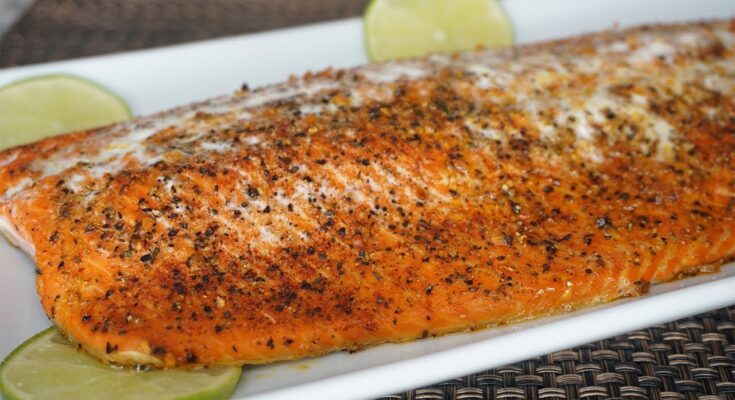Oven Baked Salmon Recipe: Salmon lovers, this one’s for you! If you’re looking for a meal that checks all the boxes—easy, healthy, flavorful, and totally satisfying—then you’ve hit the jackpot with oven-baked salmon. Whether you’re a kitchen newbie or a seasoned cook, this dish is simple enough to whip up on a weeknight and fancy enough to impress guests on a weekend.
Why is baked salmon so popular? For starters, it’s a powerhouse of nutrients—hello, omega-3s and lean protein! It’s also incredibly versatile. You can keep it classic with lemon and herbs or spice things up with bold marinades. And did we mention it’s quick? Yep, you can have dinner ready in under 30 minutes.
Let’s dive into this flavorful journey and learn how to bake salmon like a pro.
Why Choose Oven-Baked Salmon?
So, why go the oven route when cooking salmon? Honestly, it’s one of the most foolproof methods out there. Baking ensures your salmon stays moist and flaky without much effort. Unlike grilling or pan-searing, you won’t have to babysit the fish or worry about it sticking to a pan.
From a health standpoint, oven-baking uses minimal oil, which helps keep calories in check while locking in the natural richness of the fish. Plus, since you’re not frying it, you’re avoiding any extra fats or unnecessary heaviness.
Another bonus? Baking enhances flavor. When salmon cooks in the oven, it gets infused with whatever seasoning or marinade you’ve used, creating a deep, savory profile that’s hard to beat. And let’s be honest—clean-up is a breeze, especially if you line your baking tray with foil or parchment paper.
Whether you’re cooking for yourself, your family, or a dinner party, baked salmon is a reliable, crowd-pleasing option that delivers every single time.
Ingredients Needed
The beauty of baked salmon lies in its simplicity. You don’t need a long list of ingredients to make a dish that’s bursting with flavor. Here’s what you’ll need:
Main Ingredients:
- 4 salmon fillets (6 oz each, skin-on or skinless)
- 2 tablespoons olive oil
- 1 lemon (zested and sliced)
- 3 cloves garlic (minced)
- Salt and pepper to taste
Optional Add-Ins:
- Fresh herbs (like dill, parsley, thyme)
- Red pepper flakes (for a spicy kick)
- Honey or maple syrup (for a touch of sweetness)
- Dijon mustard or soy sauce (for a tangy twist)
Feel free to mix and match based on your taste preferences. Love Mediterranean flavors? Add olives, cherry tomatoes, and oregano. Want something sweet and spicy? Try a honey-sriracha glaze.
The idea is to enhance the natural flavors of the salmon without overwhelming it. Always opt for fresh ingredients when possible—they really do make a difference in the final dish.
Choosing the Right Salmon
Before you even turn on the oven, picking the right salmon is key. There’s a lot of debate over wild-caught vs. farm-raised, and while both have their merits, wild-caught salmon is typically leaner, has a stronger flavor, and contains fewer contaminants. On the flip side, farm-raised salmon is usually more affordable and readily available.
You’ll also want to consider freshness. Fresh salmon should have a mild ocean scent, not a fishy one. The flesh should be firm and moist, not slimy or dry. If fresh isn’t an option, frozen salmon works just fine—just be sure to thaw it thoroughly in the fridge before baking.
Skin-on fillets help hold the fish together during baking and add extra flavor. If you prefer skinless, that’s totally fine too—just handle them a bit more gently so they don’t break apart.
One more tip? Go for evenly sized fillets to ensure they cook at the same rate. This way, you won’t end up with some overdone and others undercooked.
Prepping the Salmon
Alright, you’ve got your perfect piece of salmon—now let’s get it ready to bake. Start by giving it a quick rinse under cold water, then pat it dry with paper towels. Removing excess moisture helps the oil and seasonings stick better.
If your salmon has pin bones (those tiny, thin bones), use a pair of kitchen tweezers to pull them out. This step isn’t mandatory, but it does make eating the salmon a lot more enjoyable, especially for kids or guests.
Now, for the marinade or seasoning. Drizzle olive oil over each fillet and rub it in to coat evenly. This helps keep the salmon moist and acts as a flavor carrier. Then, season generously with salt, pepper, and any herbs or spices you love.
For a simple marinade, combine olive oil, lemon juice, minced garlic, and chopped herbs. Let the salmon soak in this for at least 15–30 minutes in the fridge. This gives the flavors time to infuse and keeps the fish juicy during baking.
Once prepped, let the salmon sit at room temperature for about 10 minutes before baking. This step helps it cook more evenly and reduces the risk of drying out.
Seasoning Suggestions
Let’s talk flavor—because baked salmon doesn’t have to be bland. Seasoning is where you can really let your taste buds take the lead. The key is to enhance the natural taste of salmon without overshadowing it. You’ve got endless possibilities here, from fresh herbs to global-inspired marinades.
Classic Seasonings:
- Lemon zest and juice
- Fresh or dried dill
- Crushed garlic
- Sea salt and cracked black pepper
- Olive oil
These ingredients form the foundation of a traditional baked salmon flavor profile—light, citrusy, and aromatic.
Marinade Ideas:
- Honey Garlic Glaze: Mix honey, minced garlic, soy sauce, and a squeeze of lemon.
- Asian-Inspired: Blend soy sauce, sesame oil, grated ginger, and rice vinegar.
- Spicy Cajun: Combine Cajun seasoning, paprika, cayenne pepper, and olive oil.
- Mediterranean Style: Use olive oil, chopped olives, sundried tomatoes, oregano, and a splash of balsamic vinegar.
You can even go minimalist—just olive oil, salt, pepper, and lemon juice are enough to create a fresh, clean taste.
When using a dry rub, make sure it covers the fillets evenly, pressing gently so it adheres. For marinades, allow at least 30 minutes of rest time (or even overnight) in the fridge for deeper flavor absorption.
The more comfortable you get, the more adventurous you can be. Try different combos each time you bake—it’s a fun way to keep your meals exciting!
Preheating the Oven
This might seem like a small step, but don’t skip it. Preheating your oven ensures even cooking from the moment your salmon goes in. A cold oven means your fish starts cooking slowly, which can result in uneven texture and dryness.
Optimal Temperature:
- The sweet spot for baking salmon is 375°F (190°C).
- If you want a crispier finish, you can go up to 400°F (205°C), but watch your timing closely.
Always let your oven fully preheat before placing the salmon inside. It usually takes about 10–15 minutes, depending on your appliance. A good tip? Use an oven thermometer to double-check the internal temp—sometimes ovens run hotter or cooler than the setting shows.
Also, line your baking dish or sheet with parchment paper or foil for easy cleanup and to prevent sticking. You can even form a foil “packet” around the salmon if you want to trap steam and keep the fillets extra moist.
Baking the Salmon
Now, for the fun part—getting that salmon perfectly baked! Once your oven is preheated and your salmon is seasoned or marinated to your liking, it’s time to cook.
Basic Instructions:
- Place the salmon skin-side down on a lined baking sheet.
- Bake at 375°F (190°C) for 12 to 15 minutes for individual fillets.
- If you’re baking a whole side of salmon, extend the time to 18–20 minutes depending on thickness.
Here’s a trick: if the fillets are particularly thick (over 1 inch), consider covering them loosely with foil during the first half of baking to prevent the top from drying out. Then remove the foil halfway through to let the surface get a slight golden finish.
Want extra juiciness? Add lemon slices, a bit of broth, or even a splash of white wine to the baking tray for a gentle steaming effect.
You can also bake the salmon in a foil packet (a.k.a. en papillote). This traps moisture, enhances flavor, and virtually guarantees a tender, flaky result.
Avoid flipping the salmon while baking—it’s delicate and might fall apart. Just let it do its thing, and you’ll be rewarded with perfectly cooked, succulent fillets.
How to Know It’s Done
Undercooked salmon is unappetizing, and overcooked salmon is just plain sad. So how do you get it just right?
Signs Your Salmon Is Done:
- The flesh flakes easily with a fork.
- The color changes from translucent to opaque.
- It feels firm but still moist when pressed.
Internal Temperature:
- Use a meat thermometer if you have one—you’re aiming for 125°F (52°C) for medium-rare, and 135°F (57°C) for medium.
- If you prefer it well-done, go up to 145°F (63°C), but be warned—it might start to dry out.
Still not sure? Take a peek inside the thickest part of the fillet. If it’s opaque and slightly pink in the center, you’re good to go. Remember, the salmon will continue to cook slightly after it’s out of the oven due to residual heat, so don’t be afraid to pull it a minute or two early.
The golden rule? It’s better to slightly undercook and let it rest than to go overboard and end up with a dry slab of fish.
Serving Suggestions
Now that your salmon is baked to perfection, it’s time to plate it like a pro. Pairing it with the right sides can take the whole meal to another level.
Side Dish Ideas:
- Grain Bowls: Serve with quinoa, couscous, or brown rice and a side of steamed greens.
- Roasted Veggies: Think asparagus, brussels sprouts, or sweet potatoes.
- Fresh Salads: Try arugula with cherry tomatoes, cucumbers, and a light vinaigrette.
- Mashed Potatoes or Cauliflower Mash: For a creamy, comforting touch.
You can also flake the salmon and toss it into a pasta, stuff it into tacos, or serve it cold over a salad for the next day.
For presentation, add a wedge of lemon on the side and sprinkle some chopped fresh herbs on top. A light drizzle of olive oil or a dollop of herbed yogurt sauce can also elevate the dish visually and taste-wise.
Keep it simple or get creative—either way, baked salmon is versatile enough to match any mood or meal.
Storage and Reheating Tips
Got leftovers? Lucky you! Baked salmon holds up really well for a few days if you store it properly. Whether you’re planning to enjoy it cold in a salad or reheat it for a warm dish, keeping it fresh is key.
How to Store:
- Refrigerate: Place the cooled salmon in an airtight container and store in the fridge for up to 3 days.
- Freeze: Wrap individual portions in foil or plastic wrap, then place them in a freezer-safe bag or container. It’ll last for about 2–3 months in the freezer.
Pro tip: If you’re freezing salmon, try to remove as much air as possible to prevent freezer burn. Label it with the date so you know how long it’s been stored.
How to Reheat:
- Oven: Preheat your oven to 275°F (135°C), place the salmon on a baking sheet, cover loosely with foil, and warm for about 10–15 minutes. This method retains moisture better than microwaving.
- Microwave: Use this method only if you’re in a rush. Place the salmon on a plate, cover with a damp paper towel, and heat in 30-second bursts to avoid drying it out.
- Stovetop: Reheat gently in a nonstick skillet over low heat with a little bit of olive oil or butter.
And don’t forget—you can also enjoy baked salmon cold! Flake it over salads, add it to sandwiches, or mix it into a creamy pasta for a quick next-day lunch or dinner.
Common Mistakes to Avoid
Even though oven-baked salmon is pretty straightforward, there are a few common pitfalls that can ruin an otherwise perfect meal. Let’s make sure you steer clear of them.
1. Overcooking the Salmon
This is probably the number one mistake. Salmon cooks quickly, and it’s easy to leave it in just a few minutes too long. Always check for doneness early and use a thermometer if you’re unsure. Remember, the fish continues to cook slightly after it’s removed from the oven.
2. Skipping the Preheat
A cold oven leads to uneven cooking and can mess with the texture. Always preheat your oven so your salmon bakes evenly from the start.
3. Not Seasoning Enough
Salmon has a rich flavor, but it still needs a bit of help. Don’t be afraid to use salt, herbs, lemon, or spices to enhance it. A bland piece of fish is a missed opportunity.
4. Using the Wrong Pan
Using a glass or ceramic baking dish can sometimes lead to soggy salmon if the juices pool up. A metal baking sheet or foil-lined tray helps heat circulate better and gives a cleaner texture.
5. Not Letting It Rest
Let your salmon rest for 3–5 minutes after baking. This helps the juices redistribute and keeps every bite tender and moist.
Avoiding these common slip-ups can take your oven-baked salmon from decent to absolutely delicious.
Nutritional Value of Baked Salmon
Let’s be real—salmon isn’t just tasty, it’s a nutritional superstar. Baking it helps preserve all the goodness without adding unnecessary calories or fats. Here’s a breakdown of what you’re putting on your plate:
| Nutrient | Per 6oz Cooked Fillet |
|---|---|
| Calories | ~367 |
| Protein | ~34g |
| Fat | ~22g (mostly healthy fats) |
| Omega-3 Fatty Acids | ~1.5–2g |
| Vitamin B12 | 100%+ DV |
| Selenium | 80% DV |
| Potassium | ~15% DV |
The omega-3 fatty acids in salmon are a major plus. These healthy fats are known to boost heart health, reduce inflammation, and support brain function. Plus, it’s rich in B vitamins, potassium, and antioxidants.
If you’re watching your weight or following a high-protein diet, salmon is a great go-to. It fills you up without making you feel sluggish and pairs well with almost any diet—keto, paleo, Mediterranean, you name it.
So yes, that delicious meal is also doing amazing things for your body. Win-win.
Variations of Oven-Baked Salmon
Once you’ve mastered the classic baked salmon, the fun really begins. There are so many ways to switch things up and keep dinner exciting. Here are a few delicious variations to try:
1. Asian-Inspired Salmon
Use a soy sauce, sesame oil, and ginger marinade. Sprinkle with sesame seeds and chopped scallions before baking. Serve with jasmine rice and steamed bok choy.
2. Mediterranean Style
Top with cherry tomatoes, kalamata olives, red onion, capers, and a sprinkle of oregano. Finish with a drizzle of olive oil and a splash of lemon juice. Serve with couscous or pita bread.
3. Spicy Cajun Salmon
Rub fillets with a homemade Cajun spice blend (paprika, cayenne, garlic powder, onion powder). Add a bit of brown sugar for balance. Serve with cornbread and coleslaw.
4. Herb Crusted Salmon
Mix panko breadcrumbs with chopped parsley, thyme, and grated parmesan. Press onto the top of the fillet before baking for a crispy, flavorful crust.
5. Honey Mustard Glazed
Whisk together Dijon mustard, honey, olive oil, and lemon juice. Brush generously over the salmon before baking. It creates a sweet and tangy glaze that caramelizes beautifully.
There are endless ways to make oven-baked salmon your own. Don’t be afraid to experiment and mix flavors from different cuisines!
FAQs about Oven Baked Salmon Recipe
1. What temperature should I bake salmon in the oven?
Preheat your oven to 375 degrees Fahrenheit (190 degrees Celsius) for the best results. This temperature allows the salmon to cook through evenly without drying out.
2. How long does it take to bake salmon?
Typically, salmon takes about 12-15 minutes to bake in a preheated oven at 375 degrees Fahrenheit. However, the exact time can vary based on the thickness of the fillets. Use a fork to check if the salmon flakes easily, which indicates it’s done.
3. Should I cover the salmon while baking?
It’s not necessary to cover salmon while baking. Leaving it uncovered helps the edges crisp up slightly and can enhance the flavor. However, if you prefer a more steamed texture, you can loosely cover it with foil.
4. Can I add other ingredients to the salmon before baking?
Absolutely! You can add a variety of herbs, spices, and slices of lemon or lime to complement the salmon’s natural flavor. Olive oil, garlic, dill, and thyme are popular additions that can be spread over the salmon before baking.
5. Is it necessary to flip the salmon during baking?
No, you do not need to flip the salmon while it bakes. Cooking it skin-side down will ensure the flesh cooks evenly and stays moist.
6. How do I know when the salmon is perfectly cooked?
The salmon is done when its internal temperature reaches 145 degrees Fahrenheit (63 degrees Celsius) or when it easily flakes with a fork. Avoid overcooking to maintain its tender texture.
7. Can I bake salmon from frozen?
Yes, you can bake salmon directly from frozen, adding about 5-10 minutes to the cooking time. Ensure it’s completely sealed in its packaging or a baking dish to prevent drying out.
Conclusion
There you have it—the ultimate step-by-step guide to oven-baked salmon. Whether you’re cooking for one, feeding your family, or hosting a dinner party, this dish never disappoints. It’s easy, healthy, quick, and endlessly versatile.
From picking the perfect piece of fish to seasoning it just right and baking it to flaky perfection, you now have everything you need to make salmon a regular (and exciting!) part of your meal rotation.
Next time you’re wondering what to cook that’s nutritious, satisfying, and low-effort, remember: baked salmon’s got your back.
So go ahead, get cooking—and let your oven do the work!



